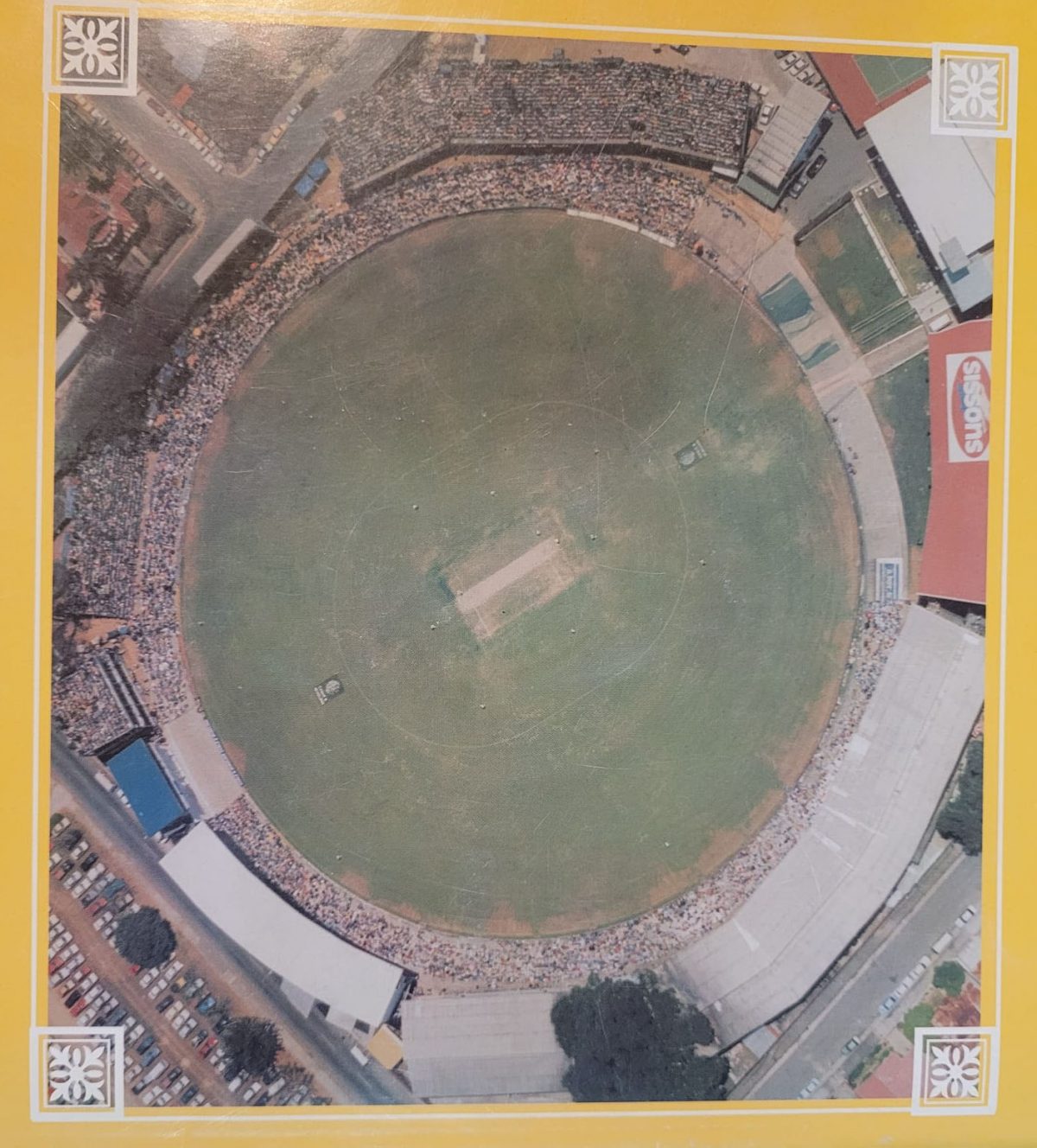In this week’s edition of In Search of West Indies Cricket, Roger Seymour recounts a One Day International (ODI) between the West Indies and Australia at the Queen’s Park Oval in Port-of-Spain, Trinidad, where he met a few characters and experienced Trinbago culture.
Prologue
The 1995 Australian Tour of the West Indies was eagerly awaited by the cricket fans throughout the Caribbean. The West Indies had just returned home after beating New Zealand 1-0 in the two-Test series, and were supremely confident in defending the Sir Frank Worrell Trophy for the eighth time since regaining it in the 1978 home series. The Australians, who had just disposed of England 3-1, Down Under, to retain the Ashes, were also brimming with confidence, whilst bearing in mind that in the last encounter, two seasons before in Australia, a 1-2 defeat, the odd Test had been decided by a single run. All eyes were focused on the highly anticipated showdown between Australian leg spinner Shane Warne, and the newly crowned Best Batsman Brian Lara, the Prince of Port-of-Spain.
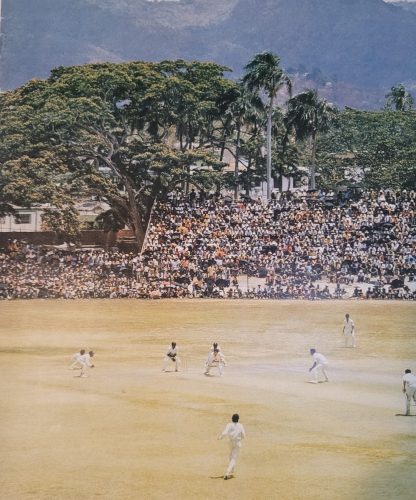
The battle kicked off with the ODI Series The hosts won the opener at Kensington Oval, Barbados, on 8th March by eight runs. Scores: West Indies: 257 off 47.4 overs; C Hooper, 84, B Lara, 55. Australia: 251 for 6, off 50 overs; D Boon, 85*. Man of the Match: C Hooper
Second ODI, Saturday, 11th
March, Queen’s Park Oval,
Trinidad and Tobago
“Oval, right away. Oval! Oval!” screamed the taxi driver, his arms flaying in all directions, as he beckoned at every passerby. “Fastest way to the cricket is right here.”
I was the first to heed his cry, and settled for the front seat. The taxi filled in a jiffy, and we were on our way. At 7.20 am, the taxi swung into Independence Square, with the recently christened Brian Lara Boulevard, separating the two streets of the centre of Port-of-Spain.
“You going at a good time,” the taxi driver assured me, as he confronted the fast paced traffic. I sighed, relieved to know that I had beaten the enormous crowd expected, only for the driver to add a few seconds later, “They were there since three o’clock this morning and they went in by five 5 o’clock.”
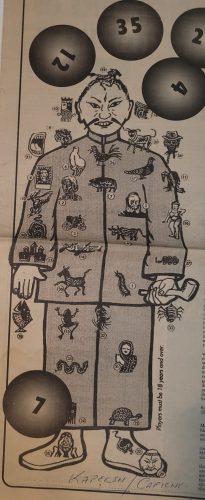
Within ten minutes we were at the Oval. Things were quiet as I ambled around the outer high walls of the ground. Business was slow for the ticket touts operating at the corner of Tragarete Road and Havelock Street, as a couple of policemen kept an eye on the traffic. A boy was hawking newspapers, shouting the headline, “Richie out of Oval clash.”
I had arrived at Piarco International Airport on Friday morning and spent the evening with some friends. Entering the ground, I adhered to their advice, eschewing the press box for the cycling track; a smooth banked concrete surface encircling the ground, on which the patrons sat. I navigated the packed crowd, eventually found an open spot, and sat savouring the moment.
I slowly absorbed the scene. With the exception of the virtually empty Members Pavilion, the place appeared to be filled to capacity. The colourful crowd, basking in the brilliant sunshine of a clear blue sky, was buzzing with anticipation. Having listened previously to radio commentary by the likes of the Englishman Henry Blofeld and Trinidadian Gerry Gomez, the former West Indies all-rounder, articulating the picturesque beauty of the Oval, ranked among the most scenic Test grounds in the world, the stunning backdrop of the hills of the Northern Range extended before my eyes. I feasted on the live art for a few solitary moments.
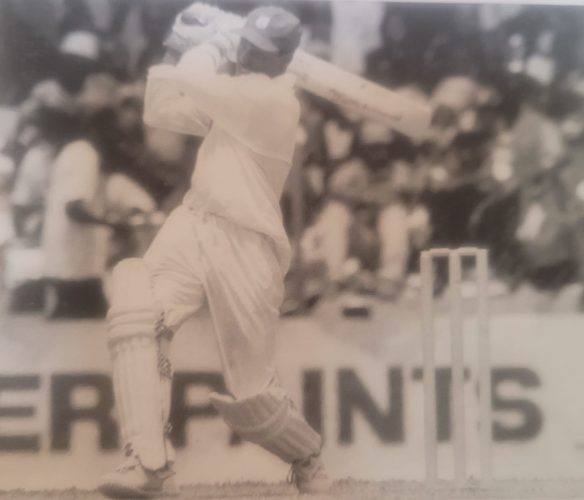
It was still early. I adjusted my broad-brimmed Maroon West Indian hat, popularised by Richie Richardson and turned my attention to the day’s editions of the Trinidad and Tobago Newsday, and Express, quietly admonishing my oversight in not securing a copy of the Guardian. As I did, a cry rose above the din, “Soft on the bumsee. All sponges from Spongy International are guaranteed for the day. Three dollars only. The concrete is not getting any softer. Spongy International.”
The top cushion salesman at the Oval for the five years was holding aloft in one hand, a piece of rough sponge, about 12 inches square and two inches thick, and in the other, a large bag, bulging at the seams. It took several minutes to acquire this necessity, as it appeared everyone wanted one.
A few feet to my left, a group of four young men were heavily engrossed in All Fours, a card game. Out on the field, as the two teams went through their warm-up routine, “Production” was circling the perimeter, proudly bearing the ‘Sun-Sea-Sand’ banner, as the national flag of Trinidad and Tobago is called. Always dressed in its colours, he was accepted as the official flag bearer at all national and international sporting events. He maintained a hectic pace for over an hour. At the interval he resumed his routine, sparing a few moments to inform me that he was truly a Caribbean man. Born of a Barbadian father and a Vincentian mother, the then 57-year-old Gerald Lewis believed that in an earlier life he was a flag carrier for the Pharaohs.
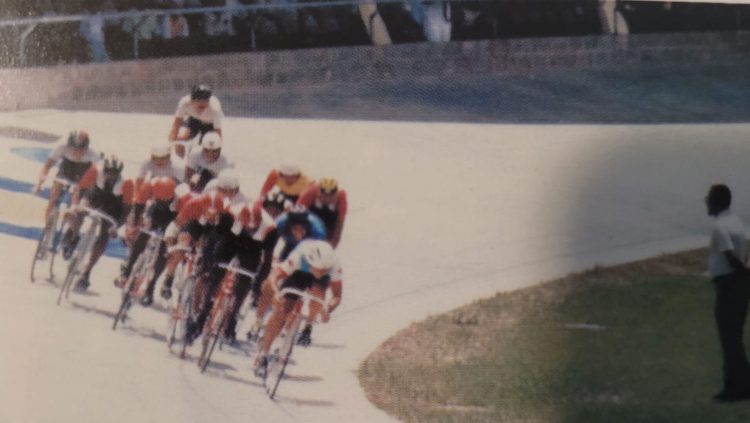
An idyllic setting for an international cricket match, the Queen’s Park Oval has been around since 1896, and its rich history includes hosting two of the earliest English cricket teams to venture in these parts; A A Priestley’s XI and Lord Hawke’s XI, both in the early months of 1897. Just shy of a century later, it’s the largest cricket ground in the Caribbean, and for that day’s clash, was bursting at the seams. (Match reports stated an attendance of 22,000. The Queen’s Park Cricket Club Centenary Magazine cites a maximum capacity of 25,000).
A buzz went around the ground as Australian Captain Mark Taylor, and acting West Indies Skipper Courtney Walsh began the traditional walk to the pitch to spin the toss. Taylor called correctly and elected to bat.
“Boy watch out, we in for a rough time today. Look Umpire Bucknor marking his run-up,” shouted Mohamed, one of the All Fours players. As Walsh got ready to deliver the second over, Umpire Bucknor, for reasons known only to himself, kicked at the turf in a manner not unlike one of the West Indian fast bowlers.
It was the first of a never-ending stream of classic picong, a form of gilt-edged humour unique to Trinidad and Tobago. Friends engage in teasing and heckling each other, treading a line between humour and insult. The best demonstration of this is found in calypso music where the element of insult is cleverly skirted by the composer.
Australia lost their captain with the score on 37, caught by Walsh off Ambrose, provoking
Mohamed’s wry observation: “Boy, you see what captaincy does do for your fielding”. And when Mark Waugh followed two runs later, he added, “Bu’ look at you, you dry up, clumsy kangaroo. We gon curry yuh duck and send yuh quacking back.”
Michael Slater and David Boon consolidated the innings for a time. When Vasbert Drakes’ first over conceded nine runs, one of the card players screamed, “The only way yuh get game was because Holford [Chairman of the Selectors] wanted to play a Bajan.”
In the 24th over, Carl Hooper calmly held the full-blooded return drive from Michael Slater to leave Australia 93 for 3. A voice to my right yelled, “Check yuh hand boy, I sure it mark ‘High Test’ now.”
“That’s his right hand, the left mark ‘Made in India,’” floated from nearby. Soon after, the crowd went wild when David Boon was dismissed for 48, caught hooking off hometown hero Phil Simmons.
Then followed the great argument, spurred by an appeal for run out, as to which light meant what, as the Third Umpire, Ralph Gosein reviewed the videotape. One wise spectator eventually posited: “Listen fellas, red is for danger, hence the batsman is out. Green is okay for him to continue batting.”
Australia were 162 for five off 38 overs, following the red light. Steve Waugh, with support from wicketkeeper Ian Healy, then led the rear guard fightback. Waugh’s half century, 58, off 59 balls included five boundaries and a straight six off Simmons, which was greeted with a long round of whistling and banging. When Waugh was bowled by Walsh, after pulling the previous delivery for four, Australia were 206 for 6 in the 44th over.
Scampering between the wickets, Healy and new batsman, Paul Reiffel, added vital runs, as the West Indies got complacent in the field. The knowledgeable crowd appreciated the Australian’s aggressive approach, constantly applauding their efforts. The picong never ceased: “Shot boy! You see dat boy? Dey ain’t call you Rifle fuh nothing, yuh know!”
The last over of the Australian innings saw the crowd on its feet. Winston Benjamin clean bowled Reiffel with the first delivery. Shane Warne wangled three off the next ball, followed by a brace, and a single by Healy to raise his 50. A single off the penultimate delivery, returned the strike to Healy, who led a mad dash for a couple. Stuart Williams’ accurate return from point to wicketkeeper Junior Murray, found Healy short of his ground. Healy’s 50 came off 43 balls, and was mainly responsible for Australia garnering 79 runs from the last ten overs, and posting a score of 260 for eight off 50 overs.
The lunch break saw the return of Production, an offering of a plate of pelau and a Carib (beer) from the All Fours party, and the great debate of the 1 pm draw for Play Whe.
“Look yuh can’t come to de Oval and refuse my family pelau. My aunt does make de best pelau in Point Fortin. Dey trying to find out she secrets for years now. All I know is that she uses pigeon peas, chicken and coconut milk. What herbs she does add, and how much sugar she burns for flavour and colour, ah can’t say. Boy, it does taste real good!” It was the first time one of the All Fours players had spoken for the day. The pelau, similar to Guyanese Cook-up rice, was delicious, and the Carib was the perfect accompaniment.
Mohamed then explained the game of Play Whe in a nutshell. The Trinidadian version of a Chinese gambling game called Chinapoo, introduced by Chinese labourers, the game of chance used dreams associated with numbers, he related. He added that it was called Whe Whe in the countryside where it was very popular, returns on stakes were excellent and everyone played, although it was illegal.
“Well you know we have a song, a calypso, for everything. A couple years ago, [1982] the Mighty Penguin had a tune named ‘Whe Whe Banker’. Then the government decided to capitalise on this game, and the National Lotteries Control Board adopt it, modify it with some local names, call it Play Whe and legalise their version. It is played from Monday through Saturday, with two daily draws at 1 and 6.30 in the evening. Check your newspapers and read de ‘On Your Mark’ guide. You can try your luck in dis evening draw,” he added.
The newspaper’s guide advised on ‘the last play’, the numbers ‘coming under’, ‘today’s best bets’, ‘outside shots’, ‘the four numbers most played on that day’. Each number had a ‘mark’, a ‘spirit’ and a ‘dream’. For instance, the mark for the number 18 was waterboat, the spirit was Housecat, and the dream was iguana, teeth, crocodile, coffin, sailing, and glass. The number drawn at 1 pm was 33, whose mark was the spider.
“Boy, I play four [mark was deadman], cause I say is pure four Lara gun lash today,” a voice on my right lamented.
The quiet card player, who had fallen asleep after a hefty serving of pelau, was nudged by his partner: “What you dreaming? Let me know nuh, I gon check de dream guide and see if I could win the evening drawing.”
“Is way you been all day? We say yuh get fired, you lose de wuk, or you get lost, or you forget de way to de Oval. Let me get five bags of yuh fresh nuts. Boy is whole day we waiting pun you,” Mohamed addressed Jumbo, the principal nut seller in the Oval, who had magically appeared in front of us.
“You fellas from South, don’t realise that we up here does work for a living. You think we liming all day like you folks down South?” Jumbo replied. His trademark was not his lengthy Rastafarian locks, but the uncanny delivery of little brown paper bags of baked peanuts. Spectators seated 15 or 20 rows back signalled their preference and the bags were lobbed into their hands with amazing accuracy. Payment was passed down via members of the crowd.
Play resumed at 2 pm. Simmons drove McDermott’s first delivery for four, awakening the drowsy crowd. In the next over, Williams fell to Reiffel, via the LBW route, Five for one. The spectators were on their feet. Flags waved, conch shells and whistles blew, seats banged on with any obstacle within reach. The chant began, “Lara, Lara, Lara.” The Prince of Port-of-Spain was on his way to the wicket, and the enthralled crowd chanted his name until he arrived at the crease. It was his first appearance in an international match at the Oval since his record-breaking year of 1994.
The spectators were all abuzz as the two sons of the soil set about the Australians. In the eleventh over, the Mexican Wave started in the Learie Constantine Stand and completed two circuits of the Oval, as the participants in every stand tried to outperform the others. The West Indies’ were on 50.
Around three o’clock, Warne was introduced into the attack, and immediately dispatched for two fours. Hooper replaced Simmons who was bowled by Glen McGrath for 34. 79 for two. Hooper was instantly at home, confidently playing everything off the middle of the bat. In the 20th over, the West Indies’ total passed the century mark, as Lara reached 50. Warne was withdrawn; his four wicket-less overs having yielded 35 runs.
The crowd’s response was sharp. The School Boys Mound began to chant “We want Shane, We want Shane,” followed by a few quick stanzas of, “Oh bring back Shane Warne, Bring back, Bring Back, Oh Bring Back Shane Warne for me…”
Lara then nicked the thinnest of edges to Healy off Blewett, and promptly walked not waiting for the umpire’s decision. His innings of 62 had come off of 72 balls. In adding 42 runs, Lara and Hooper had batted with such consummate ease, making the mysterious Warne look like an ordinary bowler. One got the impression that the West Indies would win with overs and wickets to spare. Lara’s departure, when he was well set, was met with a hushed silence, in stark contrast to his much heralded arrival. 121 for three.
Jimmy Adams joined Hooper, and the score continued to tick along nicely. Hooper hooked Blewett for six to raise his 50 and the partnership’s. These milestones were greeted with two more circuits of the Mexican wave. WI nicely poised on 175 for three.
Warne was recalled, and Hooper gave the simplest of catches to Blewett at mid-wicket from a Warne full toss. Until that momentary lapse in concentration, Hooper had been in absolute control. His score of 55, was his eighth half-century in his last 12 ODIs. The innings fell apart. Adams was stranded in mid-pitch when Arthurton refused his call for a run. Reiffel trapped Murray LBW for a duck, and then returned the compliment Benjamin had paid him by clean bowling him.
Arthurton found a worthy partner in Drakes; they added 41. The odds were mounting against them at this stage, and following Arthurton’s exit at 232, the West Indies quickly folded to 234 all out off 47.5 overs. Australia won by 26 runs to level the series at 1-1. Healy was bestowed with the Man of the Match title.
As the disappointed crowd dispersed from the Oval, someone yelled the final picong: “Is all them Mexican waves make Lara and Hooper seasick and make we lose.”
Postscript
The Third ODI was played the next day, also at the Oval. It was bacchanal again for the Trinis just two weeks after Carnival as the West Indies romped home by 133 runs. Lara slammed 139 off 125 balls, including 15 boundaries and three sixes, as the hosts compiled 282 for five off 50 overs, their third highest ODI score against the Australians. It was Lara’s fifth ODI ton and his first international century on home turf. With Hooper, he added 99 for the third wicket, as the visitors were displaced by an array of shot making. The Third Umpire was busy all day, and pressed the red light on four occasions.
Eschewing the press box, I witnessed the West Indies innings from the scoreboard, manned by students of Queen’s Royal College – an old tradition – under the supervision of one of their teachers.
West Indies won the ODI series 4-1, but surrendered the Sir Frank Worrell Trophy 2-1 losing a Test series for the first time in 15 years.
That Monday, the Express carried a full page article on major businesses complaining about Lotto and Play Whe siphoning off their profits. Today, Whe Whe is still illegal but there are four daily draws for Play Whe at 10.30 am, 1 pm, 4 pm, and 7 pm, Monday to Saturday.
In 2021, Brian London released a classic calypso “All Fours – No Trump.” Mohamed was right, there was a song for everything.
